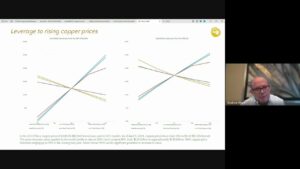Montreal, Quebec – (July 20th, 2016) Cyprium Mining Corporation ("Cyprium" or the "Company") (TSX-V: CUG and CUG.DB) is pleased to announce the results from 71 additional underground samples taken from the Tunel body as part of its ongoing exploration program of the Potosi silver mine located in Santa Eulalia, Mexico. Of the 71 samples taken, 34 were channel samples taken at the edges of old stopes on levels 1 and 2, and 37 samples were of previously broken mineralized rock from levels 1, 2 and 3 that was left behind at the end of the last mining in this area. All samples were taken in areas where Cyprium expects initial production to take place (1).
The 34 channel samples were taken on exposures of relatively flat lying manto and steep chimney mineralization on levels 1 and 2. Not including eight samples of oxidized mineralization from a chimney on level 2, 26 samples averaged 238g/t Ag, 5.28% lead, and 8.04% zinc over an average sample width of 1.2 m. The table below shows averages for sampling on different levels of the Tunel body, including some previously reported sampling from levels 3 and 4 (see press release of June 9, 2016 and June 13, 2016). All of these exposures are at the margins of historic workings near the Potosi No. 3 shaft. The shaft has been reconditioned with a haulage system capable of removing approximately 100 tons per day (1) and compressed air and water have been brought in, with an air compressor installed on Level 2.
Previously broken rock, termed 'muck' or in Spanish, 'rezaga' was left behind in old stopes and mineralized material passes in several places within the Tunel body. This material has been moved down to the haulage level (level 2) to be removed from the mine via the recently rehabilitated and now operational shaft No. 3. The assays from this material average 173 g/t silver, 4.8% lead and 3.9% zinc for an average sample weight of 6.1 kg and a total of 224 kg. It is estimated that enough tonnage of this material is ready to be removed from the mine to conduct the initial extraction tests, ahead of the Company's expected explosive permit grant.
| Area | Samples | Width m | Au g/t | Ag g/t | Pb% | Zn % | |
| Level 1 manto | 9 | 0.9 | – | 317 | 6.34 | 10.08 | |
| Level 1 chimney | 11 | 1.4 | – | 196 | 4.48 | 7.15 | |
| Level 2 manto | 6 | 1.1 | – | 243 | 5.87 | 7.65 | |
| Level 3½* | 13 | 1.5 | 0.074 | 206 | 6.40 | 5.99 | |
| Level 4 manto Zone A** | 18 | 1.4 | – | 194 | 0.78 | 0.58 | |
| Level 4 manto Zone B** | 19 | 1.4 | – | 192 | 1.12 | 0.61 | |
| Level 4 high grade vein | 6 | 1.0 | 0.295 | 646 | 6.35 | 2.87 | |
* Some samples from this interval were previously included in the news releases of June 13, 2016.
The results announced today are part of an ongoing exploration program to evaluate the potential of known mineralization in the Tunel body near the Potosi No. 3 shaft. This shaft has been rehabilitated and provides access for services such as compressed air and for haulage of broken mineralized rock from the Tunel body on levels 2 to 4 (see News Releases of June 9 and Jun13, 2016) where underground exploration and development will begin shortly. Work is also in progress for the Santo Domingo body, also known as Main Silicate body, which was also partly mined in the past at levels 9 to 11. Efforts are underway to determine the volume and grades of remaining material in this area, which is not accessed by the Potosi No. 3 shaft. Past production from the Santo Domingo body was from the Potosi No. 1 and Potosi No. 5 shafts and from a shaft on neighboring ground controlled by a third-party. Plans for gaining access to the Santo Domingo body are currently in consideration.
Mineralization in the area where the samples were taken is exposed in a large chimney that extends over several levels. Although most of the mineralization on the upper levels of the Potosi mine is oxidized, local areas with preserved sulfides on the upper levels were discovered in the last few decades (2). The main exposures of sulfide mineralization studied to date are on levels 9 to 11, but the sulfide material also extends upward to level 6. Such sulfide orebodies were not economically exploitable prior to the advent of selective flotation in the early 1900's and were evidently left behind for this reason and later forgotten. These “perched” sulfide bodies were possibly preserved due to the vagaries of past oxidation.

Composite level map of the Potosi Mine showing areas projected for exploration.
The workings discussed in this press release are shown on a composite projection in different colors for each level, and include the main adit and 0 level tunnel, Potosi shafts No. 3 and No. 1, and the stopes on levels 2 to 4 (Tunel body), 6 and 9-10 (Santo Domingo or Main Silicate body).
The Santa Eulalia District
Santa Eulalia is a world class polymetallic mining district located in the central part of the State of Chihuahua, Mexico, approximately twenty-two kilometers east of the City of Chihuahua. Mineralization in the area was originally discovered during the Spanish colonial period in the 1500's, and recorded production has occurred over more than 300 years. Santa Eulalia ranks as one of Mexico's primary silver and base metal producing districts with nearly 450 million ounces of silver and substantial amounts of lead and zinc mined. The nature of the deposit in the Santa Eulalia district is a carbonate replacement deposit and is the historically largest of its type in Mexico. Mineralization occurs in an area about 10 km in length and 5 km in width. Production and reserves for the district have been estimated to be about 50 million metric tons (3) with grades of 125-350 g/t Ag, 2-8% Pb and 3-12% Zn (3) (4), along with appreciable quantities of tin and vanadium.
The Santa Eulalia district covers approximately forty-eight square kilometers and is divided into three areas, the West Camp, the Central Camp and the East Camp. The Potosi silver mine is located in the West Camp. The West Camp has produced most of the minerals from the district from an area 4 km long in a north-south direction and 2 km wide in an east-west direction, with the Potosi silver mine being one of the primary producers.
Based on the geology, past mining activity and the exploration work completed by the Company to date, the Potosi mine, the Company believes that the project warrants further exploration. Widely spaced sampling on levels 2 to 4 in the area of the Potosi No. 3 shaft (Tunel body) and levels 6 and 9-11 in the area of the Potosi No.1 shaft (Santo Domingo or Main Silicate body) has shown that mineralized material of interesting grades is exposed at the margins old stopes and adjacent areas, and this work will continue in order to evaluate the potential for defining resources.
Geological Setting, Deposit Type and Mineralization
Mineralization in the Santa Eulalia district is characterized by massive sulfides, dominantly pyrrhotite, sphalerite, galena and pyrite that are hosted mainly in horizontal mantos and steep chimneys of sulfide material that replace limestone, with some breccia bodies also occurring. Mineralized bodies occur along laterally continuous discrete structural zones that mainly trend in a north-south orientation, with mineralization forming preferentially in certain stratigraphic units. Past mining has reached to as much as 700 meters depth below the surface on 21 levels. Production in the West camp was diminished until the late 80's with the discovery of new mineralization. Currently there is little production in the district.
National Policy 43-101 Report
Cyprium has engaged Dr. Craig Gibson to complete a National Instrument 43-101 report with respect to the initial mine levels 2, 3 and 4 of the Potosi silver mine. It is expected the report will be completed before the end of June 2016. The report to be prepared by Dr. Gibson shall not contain a resource or reserve calculation.
Quality Assurance and Control
Samples taken in underground workings are typically channel samples. Sample cuttings consist of rock chips taken along pre-marked channels approximately 15-20 cm in width that span the mineralized zone and are collected at the site by an experienced sampling crew under the supervision of a Company geologist. Sample material generally consists of from 2.0 to more than 4.5 kg of material that is placed in labelled plastic bags that are sealed with ties at the collection site. Samples taken of the broken rock ranged from 2.35 to 11.27 kg and were taken from various areas of the volume of rock. The samples were transported from the mine and stored at the Company's or contractor's surface facilities and subsequently taken directly to the lab preparation facility. The samples are transported in Company vehicles and delivered to the sample preparation facility by personnel of the company or contractor.
All samples were analyzed in Vancouver for the reported metals by the ME-OG62 method for higher grade samples. Internal control samples were added to the sample stream every 20th sample and the laboratory applies strict quality control procedures. ALS Chemex is part of ALS Global, an internationally recognized analytical laboratory.
About Cyprium Mining Corporation
For further information, please contact:
Alain Lambert, Chairman and C.E.O.
[email protected]
Phone: + 1 514 219 7988 or + 52 1 614 253 5803
Ron Keenan, C.O.O.
[email protected]
Phone + 1 514 915 3836
Neither TSX Venture Exchange nor its Regulation Services Provider (as that term is defined in policies of the TSX Venture Exchange) accepts responsibility for the adequacy or accuracy of this release.
Qualified Person: Dr. Craig Gibson, Certified Professional Geologist, prepared the summary of public historical information on the Santa Eulalia district, and has reviewed the appropriate portions of this news release and approved the contents thereof. Public information included in this release are based on work by from a PhD dissertation by Peter K. M. Megaw and information from the Mexican Geologcial Survey (Servicio Geologico Mexicano).
References:
(1) See important disclaimer in bold below.
(2) P. Megaw, pers. Comm.
(3) Megaw, P.K.M., 1990, Geology and geochemistry of the Santa Eulalia mining district, Chihuahua, Mexico, unpublished PhD dissertation, University of Arizona, 461 pp.
(4) Bustos-Diaz, J.L. and Arzabala-Molina, J., 2007, Monografia Geologico-Minera del Estado de Chihuahua, Servicio Geologico Mexicano, 640pp.
This news release contains "forward-looking information" (within the meaning of applicable Canadian securities laws) and "forward -looking statements" (within the meaning of the U.S. Private Securities Litigation Reform Act of 1995). Such statements or information are identified with words such as "anticipate", "believe", "expect", "plan", "intend", "potential", "estimate", "propose", "project", "outlook", "foresee" or similar words suggesting future outcomes or statements regarding an outlook. Such statements include, among others, those concerning the Company's anticipated plans for developments of the Company and its mining projects”.
Such forward-looking information or statements are based on a number of risks, uncertainties and assumptions which may cause actual results or other expectations to differ materially from those anticipated and which may prove to be incorrect. Assumptions have been made regarding, among other things, management's expectations regarding future growth, plans for and completion of projects by Company's third party relationships, availability of capital, and the necessity to incur capital and other expenditures. Actual results could differ materially due to a number of factors, including, without limitation, operational risks in the completion of Company's anticipated projects, delays or changes in plans with respect to the development of Company's anticipated projects by Company's third party relationships, risks affecting the ability to develop projects, risks inherent in operating in foreign jurisdictions, the ability to attract key personnel, and the inability to raise additional capital. No assurances can be given that the efforts by the Company will be successful. Additional assumptions and risks are set out in detail in the Company's MD&A, available on SEDAR at www.sedar.com.
Although the Company believes that the expectations reflected in the forward-looking information or statements are reasonable, prospective investors in the Company's securities should not place undue reliance on forward-looking statements because the Company can provide no assurance that such expectations will prove to be correct. Forward-looking information and statements contained in this news release are as of the date of this news release and the Company assumes no obligation to update or revise this forward-looking information and statements except as required by law.
Investors should note that the Potosi silver mine and La Chinche property have no established mineral resources or mineral reserves as defined by NI 43-101. Although Cyprium Mining has made a production decision regarding the Potosi silver mine based on historical production records and results from recent sampling, a feasibility study of its projects has not been completed and there is no certainty that the proposed operations will be economically or technically viable. It must be understood that any such production would be from unmeasured mineralized material. The Company further advises that since its production decision was not based on a feasibility study of mineral reserves demonstrating economic and technical viability there may be an increased uncertainty of achieving any particular level of recovery of minerals or the cost of such recovery, including increased risks associated with developing a commercially mineable deposit. Historically, such projects have a much higher risk of economic and technical failure. These risks, among others, include areas that are analysed in more detail in a feasibility study, such as applying economic analysis to resources and reserves, more detailed metallurgy and a number of specialized studies in areas such as mining and recovery methods, market analysis, and environmental and community impacts. There is no guarantee that production will proceed as anticipated or at all or that anticipated production costs will be achieved. Failure of production to proceed as planned would have a material adverse impact on the Company's ability to generate revenue and cash flow to fund operations. Failure to achieve the anticipated production costs would have a material adverse impact on the Company's cash flow and future profitability.
Original Article: http://www.cypriummining.com/en/investors/news-releases/cyprium-mining-announces-additional-assay-results-and-provides-an-update-from-the-potosi-silver-mine
























